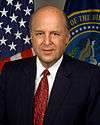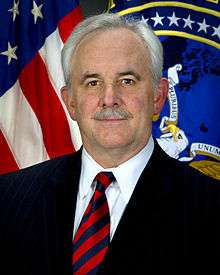Director of National Intelligence
 | |
| Agency overview | |
|---|---|
| Formed | April 22, 2005 |
| Preceding agency | |
| Jurisdiction | Federal Government of the United States |
| Headquarters |
Liberty Crossing Tysons Corner, Virginia[1] |
| Employees | 1,750[2] |
| Agency executives |
|
| Child agencies | |
| Website | www.dni.gov |
The Director of National Intelligence (DNI) is the United States government official – subject to the authority, direction, and control of the President – required by the Intelligence Reform and Terrorism Prevention Act of 2004 to:
- Serve as principal advisor to the President, the National Security Council, and the Homeland Security Council about intelligence matters related to national security;
- Serve as head of the sixteen-member United States Intelligence Community; and
- Direct and oversee the National Intelligence Program.
Further, by Presidential policy directive signed in October 2012, the DNI was given overall responsibility for Intelligence Community whistleblowing and source protection through Presidential Policy Directive 19.
Under 50 U.S.C. § 403-3a, "under ordinary circumstances, it is desirable" that either the Director or the Principal Deputy Director of National Intelligence be an active-duty commissioned officer in the armed forces or have training or experience in military intelligence activities and requirements. Only one of the two positions can be held by a military officer at any given time. The statute does not specify what rank the commissioned officer will hold during his or her tenure in either position, but historically a four-star general or admiral has served. On July 20, 2010, President Obama nominated retired Lt. Gen. James R. Clapper for the position. Clapper was confirmed by the Senate on August 5, 2010, and replaced acting Director David C. Gompert. The prior DNI was retired Navy four-star admiral Dennis C. Blair, whose resignation became effective May 28, 2010.[3]
On July 30, 2008, President Bush issued Executive Order 13470,[4] amending Executive Order 12333 to strengthen the DNI's role.[5]
History
Founding
Before the DNI was formally established, the head of the Intelligence Community was the Director of Central Intelligence (DCI), who concurrently served as the Director of the Central Intelligence Agency (CIA).
The 9/11 Commission recommended establishing the DNI position in its 9/11 Commission Report, not released until July 22, 2004, as it had identified major intelligence failures that called into question how well the intelligence community was able to protect U.S. interests against foreign terrorist attacks.
Senators Dianne Feinstein, Jay Rockefeller and Bob Graham introduced S. 2645 on June 19, 2002, to create the Director of National Intelligence position. Other similar legislation soon followed. After considerable debate on the scope of the DNI's powers and authorities, the United States Congress passed the Intelligence Reform and Terrorism Prevention Act of 2004 by votes of 336–75 in the House of Representatives, and 89–2 in the Senate. President George W. Bush signed the bill into law on December 17, 2004. Among other things, the law established the DNI position as the designated leader of the United States Intelligence Community and prohibited the DNI from serving as the CIA Director or the head of any other Intelligence Community element at the same time. In addition, the law required the CIA Director to "report" his agency's activities to the DNI.
Critics say compromises during the bill's crafting led to the establishment of a DNI whose powers are too weak to adequately lead, manage and improve the performance of the US Intelligence Community.[6] In particular, the law left the United States Department of Defense in charge of the National Security Agency (NSA), the National Reconnaissance Office (NRO), and the National Geospatial-Intelligence Agency (NGA). (The limited DNI role in leading the U.S. Intelligence Community is discussed on the Intelligence Community page.)
History (2005–2007)
On February 17, 2005, President George W. Bush named U.S. Ambassador to Iraq John Negroponte to the post, pending confirmation by the Senate. It was reported that President Bush's first choice for Director of National Intelligence was former Director of Central Intelligence Robert M. Gates, who was serving as president of Texas A&M University; however, Gates declined the offer.[7] Negroponte was confirmed by a Senate vote of 98 to 2 in favor of his appointment on April 21, 2005, and was sworn in by President Bush on that day.
On February 13, 2007, John Michael McConnell became the 2nd Director of National Intelligence, after Negroponte was appointed Deputy Secretary of State.
Donald M. Kerr was confirmed by the U.S. Senate to be Principal Deputy Director of National Intelligence on October 4, 2007 and sworn in on October 9, 2007. Kerr, from Virginia, was most recently the Director of the National Reconnaissance Office, and previously the Duty Director for Science and Technology at the U.S. CIA and earlier in his career the Assistant Director of the Justice Department's FBI.
Declan McCullagh at News.com wrote on August 24, 2007, that the DNI site was configured to repel all search engines to index any page at DNI.gov. This effectively made the DNI website invisible to all search engines and in turn, any search queries.[8] Ross Feinstein, Spokesman for the DNI, said that the cloaking was removed as of September 3, 2007. "We're not even sure how (the robots.txt file) got there" – but it was again somehow hidden the next day. Another blog entry by McCullagh on September 7, states that the DNI site should now be open to search engines.[9] This explanation is plausible because some software used for web development has been known to cause servers to automatically generate and re-generate robots.txt, and this behavior can be difficult to turn off. Therefore, if the web developers working for the DNI had tried to solve the issue by simply removing robots.txt, it would have looked like it worked at first, but then fail once the server had undergone a self-check for the robots.txt file.[10] http://dni.gov/robots.txt has been configured to allow access to all directories for any agent.
In September, 2007, the Office of the DNI released "Intelligence Community 100 Day & 500 Day Plans for Integration & Collaboration". These plans include a series of initiatives designed to build the foundation for increased cooperation and reform of the U.S. Intelligence Community.[11]
Office of the Director of National Intelligence (ODNI)
The Intelligence Reform and Terrorism Prevention Act of 2004 established the Office of the Director of National Intelligence (ODNI) as an independent agency to assist the DNI. The ODNI's goal is to effectively integrate foreign, military and domestic intelligence in defense of the homeland and of United States interests abroad.[12] The budget for the ODNI – and the Intelligence Community for fiscal year 2013 is $52.6 billion[13] and the base request for fiscal year 2014 was $48.2 billion.[13] The Military Intelligence Program (MIP) base budget request for fiscal year 2014, excluding overseas contingency funds, is $14.6 billion, which together with the NIP, comprise an Intelligence Community budget request of $62.8 billion for fiscal year 2014.[14] The ODNI has about 1,750 employees.[2]
On March 23, 2007, DNI Mike McConnell announced organizational changes, which include:
- Elevating acquisition to a new Deputy DNI position
- Creating a new Deputy DNI for Policy, Plans, and Requirements (replacing the Deputy DNI for Requirements position)
- Establishing an Executive Committee
- Designating the Chief of Staff position as the new Director of the Intelligence Staff
The ODNI continued to evolve under succeeding directors, culminating in a new organization focused on intelligence integration across the community. The ODNI has six centers and 15 Offices that, together with the centers, support the Director of National Intelligence as the head of the Intelligence Community (IC) in overseeing and directing implementation of the NIP and acting as the principal advisor to the President, the National Security Council, and the Homeland Security Council for intelligence matters related to national security. The six ODNI centers include:
- Intelligence Advanced Research Projects Agency (IARPA)
- Information Sharing Environment (ISE)
- National Counterproliferation Center (NCPC)
- National Counterterrorism Center (NCTC)
- National Intelligence Council (NIC)
- Office of the National Counterintelligence Executive (ONCIX).
ODNI Organization
The ODNI is divided into core, enabling, and oversight offices. The Principal Duty Director (PDDNI) to the DNI, in a role similar to that of a Chief Operating Officer, oversees operation of ODNI offices, manages Intelligence Community (IC) coordination and information sharing, reinforces the DNI's intelligence-integration initiatives, and focuses on IC resource challenges.
Core mission
The core mission functions of the ODNI are organized under the Deputy DNI for Intelligence Integration (DDNI/II). The DDNI/II facilitates information sharing and collaboration through the integration of analysis and collection, and leads execution of core mission functions. These include:
- Integration Management Council
- National Intelligence Council
- Mission Integration Division
- National Counterterrorism Center
- National Counterproliferation Center
- Office of the National Counterintelligence Executive
Mission enablers
Mission enablers include policy, engagement, acquisition, resource, human capital, financial, and information offices.
Oversight
Oversight offices include the General Counsel, civil liberties, public affairs, Inspector General, Equal Employment Opportunity, and legislative affairs functions.[15]
Directors
| No. | Director | Term of Office | President(s) served under | |
|---|---|---|---|---|
| 1. |  |
John Negroponte | April 21, 2005 – February 13, 2007 | George W. Bush |
| 2. |  |
VADM John Michael McConnell, USN (Ret.) | February 13, 2007 – January 27, 2009 | George W. Bush |
| 3. |  |
ADM Dennis C. Blair, USN (Ret.) | January 29, 2009 – May 28, 2010 | Barack Obama |
 |
David C. Gompert (Acting) | May 28, 2010 – August 5, 2010 | ||
| 4. |  |
Lt. Gen. James R. Clapper, USAF (Ret.) | August 5, 2010 – present | |
Principal Deputy Directors of National Intelligence
| Name | Term of Office | President(s) served under |
|---|---|---|
| Gen Michael Hayden, USAF | April 21, 2005 – May 26, 2006 | George W. Bush |
| LTG Ronald L. Burgess, Jr., USA (Acting) | June 2006 – January 2007 | George W. Bush |
| Donald Kerr | October 2007 – January 2009 | George W. Bush |
| LTG Ronald L. Burgess, Jr., USA (Acting) | January 2009 – February 2009 | Barack Obama |
| David C. Gompert | November 10, 2009 – August 2010 | Barack Obama |
| Stephanie O'Sullivan | February 18, 2011 – present | Barack Obama |
Director of the Intelligence Staff/Chief Management Officer
| Name | Term of Office | President(s) served under |
|---|---|---|
| LTG Ronald L. Burgess, Jr., USA | May 2007 – February 2009 | George W. Bush, Barack Obama |
| LTG John F. Kimmons, USA | February 2009 – October 2010 | Barack Obama |
| Mark Ewing | November 2010–present | Barack Obama |
Intelligence Community Inspector General
| Name | Term of Office | President(s) served under |
|---|---|---|
| I. Charles McCullough, III | November 2011–present | Barack Obama |
Deputy Directors of National Intelligence
| Name | Office | Term of Office | President(s) served under |
|---|---|---|---|
| Robert Cardillo | Intelligence Integration (oversees collection and analysis) | September 2010–present | Barack Obama |
| Peter Lavoy | Analysis | December 2008–? | George W. Bush |
| Vacant | Collection | April 2010–? | Barack Obama |
| David Shedd | Policy, Plans and Requirements | May 2007–? | George W. Bush |
| Dawn Meyerriecks | Acquisition and Technology | September 2009–? | Barack Obama |
Assistant Directors of National Intelligence
| Name | Office | Term of Office | President(s) served under |
|---|---|---|---|
| Deborah Kircher | ADNI for Human Capital | October 2011–present | Barack Obama |
| Al Tarasiuk | IC Chief Information Officer | February 2011–present | Barack Obama |
| Marilyn A. Vacca | Chief Financial Officer | April 2009–present | Barack Obama |
| Dr. L. Roger Mason, Jr. | ADNI for Systems & Resource Analyses | May 2009–present | Barack Obama |
| Dawn Meyerriecks | ADNI for Acquisition, Technology & Facilities | ?–present | Barack Obama |
Assistant Deputy Directors of National Intelligence
| Name | Office | Term of Office | President(s) served under |
|---|---|---|---|
| Dan Butler | Assistant Deputy Director for Open Source | April 2008–? | George W. Bush, Barack Obama |
| Andrew Hallman | Assistant Deputy Director for Intelligence Integration | September 2010–present | Barack Obama |
See also
References
- ↑ dni.gov. "Director James R. Clapper Interview With Andrea Mitchell".
- 1 2 Clark, Charles. "Lifting the Lid". Government Executive-September 2012. Retrieved 14 April 2013.
- ↑ Miller, Greg. Dennis C. Blair to resign as director of national intelligence, Washington Post. Published May 21, 2010. Retrieved June 3, 2010.
- ↑ Executive Order 13470
- ↑ "Bush Orders Intelligence Overhaul", by Associated Press, July 31, 2008
- ↑ Kaplan, Fred (7 December 2004). "You Call That a Reform Bill?". Slate (magazine).
- ↑ CNN.com (2005) Bush names Negroponte intelligence chief. Retrieved May 14, 2006.
- ↑ Declan McCullagh (2007-08-24). "Feds use robots.txt files to stay invisible online. Lame.". CNET. Retrieved 2014-02-14.
- ↑ Declan McCullagh (2007-09-07). "National Intelligence Web site no longer invisible to search engines". CNET. Retrieved 2014-02-14.
- ↑ "Auto generated robots.txt file in WordPress". Codegrad. February 10, 2013. Retrieved 2013-08-12.
- ↑ DNI.gov
- ↑ "Public Affairs Office, ODNI". Office of the Director of National Intelligence. ODNI. Retrieved 14 April 2013.
- 1 2 "National Intelligence Program" (PDF). US GPO. Retrieved 14 Apr 2013.
- ↑ "DoD Releases MIP Base Request for FY 2014". Department of Defense. Retrieved 14 April 2013.
- ↑ Public Affairs Office, ODNI. "Organization". ODNI. Retrieved 14 April 2013.
External links
- Office of the Director of National Intelligence
- US Intelligence Community
- The National Counterproliferation Center
- The National Counterterrorism Center
- The National Counterintelligence Executive
- Program Manager for the Information Sharing Environment
- Intelligence Reform and Terrorism Prevention Act of 2004
Articles
- U.S. News & World Report: First line of Defense: Inside the Efforts to Remake U.S. Intelligence
- Fact Sheet: Real Progress in Reforming Intelligence
- The Washington Post - December 29, 2006: DNI Awards $2 Million in Hush-Hush Money
- The National Security Archive: From Director of Central Intelligence to Director of National Intelligence
- U.S. National Intelligence: An Overview 2013
| ||||||||
| ||||||||||||||||||||||||
| ||||||||||||||||||||||||||||||||||

